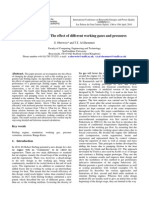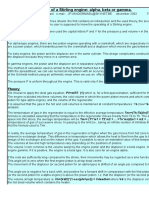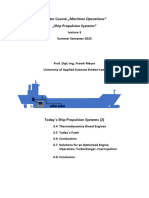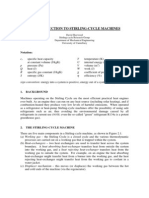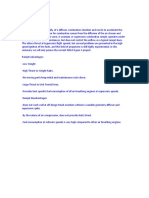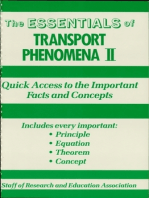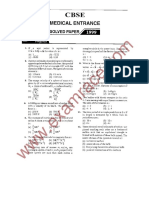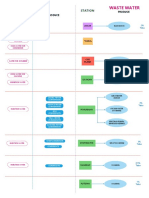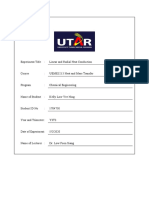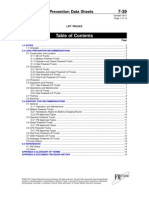Optimization of Diameter Ratio For Alpha-Type Stirling Engines
Optimization of Diameter Ratio For Alpha-Type Stirling Engines
Uploaded by
Emiliano VelázquezCopyright:
Available Formats
Optimization of Diameter Ratio For Alpha-Type Stirling Engines
Optimization of Diameter Ratio For Alpha-Type Stirling Engines
Uploaded by
Emiliano VelázquezOriginal Title
Copyright
Available Formats
Share this document
Did you find this document useful?
Is this content inappropriate?
Copyright:
Available Formats
Optimization of Diameter Ratio For Alpha-Type Stirling Engines
Optimization of Diameter Ratio For Alpha-Type Stirling Engines
Uploaded by
Emiliano VelázquezCopyright:
Available Formats
OPTIMIZATION OF DIAMETER RATIO FOR ALPHA-TYPE STIRLING ENGINES
VLAD MARIO HOMUTESCU*, DAN-TEODOR BLNESCU*
* Gheorghe Asachi Technical University of Iassy
Department of of Thermotechnics, Thermal Engines and Refrigeration
e-mail: mariohomutescu@gmail.com
Abstract: The problem of the constructive dimensioning and optimization of the Stirling machines is still
insufficiently studied. The paper analyzes the alpha-type Stirling engine from the point of view of the constructive
optimization, by choosing the optimum ratio between the diameters of the two cylinders in the machine composition.
This theoretical analysis showed that, by analyzing the functioning of the engine with either an isothermal model or
the adiabatic model without or with losses taken into consideration, an optimum value of the diameter ratio exists, for
which the work produced by the engine takes a maximum value. The optimum diameter ratio is calculated for a
numerical example.
Key words: alpha-type Stirling engine, diameter ratio optimization, adiabatic model
1. Introduction
The thermodynamic Stirling cycle [6] is composed of two isothermal processes (that take place at the
minimum and maximum temperatures of the cycle, T
m
and T
M
) linked by two isochoric processes (that took
place at the minimum and maximum volumes occupied by the gas inside the machine, V
m
and V
M
), as on
Fig. 1.
Irrespective of the architecture and the motive drive type, all Stirling engines include in their
functional unit construction (equivalent to an internal combustion monocylinder engine) the cylinder and the
displacer, the cylinder and the power piston, the heater and the cooler heat exchangers and the heat
regenerator, key components connected as shown on Fig. 2 [4].
In the case of using a crank mechanism, the indicator diagram of the engine looks like the one
presented also in Fig. 1.
The optimization of the Stirling engine functioning is a problem of major interest. Several papers
studying various aspects of the Stirling engine optimization (e.g. the optimization of the heat exchangers -
cooler, heater and regenerator - for irreversible cycles) were published [1], [2], [3].
1
0
1
0.5
1 2/4 0 1/4
p/p
max
V/V
M
4
3
2
T
M
= ct.
T
m
= ct.
0.6 V
[10
-3
m
3
]
0.5 0.7
p,
[MPa]
8
6
10
Fig. 1 - Direct Stirling thermodynamic cycle, for chosen compression ratio V
M
/ V
m
= 2, and an indicator diagram,
calculated for a numerical example
7
8
6
3
9
4
2
10
5
1
Fig. 2 - Alpha-type Stirling engine:
1 - crankshaft; 2 - displacer rod; 3 - displacer; 4 - expansion chamber; 5 - heater;
6 - regenerator; 7 - cooler; 8 - compression chamber; 9 - power piston; 10 - rod
2. Stirling Engine Performances Calculated with an Adiabatic Model
The adiabatic physico-mathematical model used for thermal performances calculation [7] is based on
the following hypotheses: the working fluid is the ideal gas, all processes occur ideally, the temperature
inside the heater is constant, the temperature inside the cooler is constant, the heat regenerator temperature is
constant and equal to the logarithmic mean of cooler and heater temperatures, the momentary pressure is the
same inside all engine chambers and the pistons move accordingly to known laws. The expansion and
compression spaces do not exchange heat with the neighboring spaces, this particularity also giving the name
of the model.
T
T
reg
T
h
T
k
V
c
, m
c
V
reg
V
h
V
e
, m
e
V
k
T
c
T
e
c - k k - reg reg - h
h - e
Fig. 3 - Schematic diagram of the alpha-type Stirling engine
The hypotheses concerning the temperatures inside the engine are shown as well in graphical manner
on Fig. 3. On Fig. 3 letters V, T and m were used to mark the volumes, temperatures and masses while the
subscripts e, c, k, reg, h refer to the expansion and the compression spaces, cooler, regenerator and heater
(they all correspond to English initials, excepting k for cooler).
The model uses the differential equation of mass conservation for the working agent, the equation of
state applied to the gas inside heat exchangers and the differential law of conservation of energy written for
the adiabatic chambers.
According to the adopted hypotheses, inside the compression and expansion chambers the gas
exchanges work with the surrounding environment (through piston movement) and enthalpy with the
neighboring heat exchangers (cooler or heater). The internal energy of the gas inside the adiabatic chambers
changes, as a consequence of mass and temperature variations. The heat exchanged by each of these two
chambers is zero, conforming to the adiabatic hypothesis.
The adiabatic model produces five differential equations:
(1)
|
.
|
\
|
+ =
c
c
k c
c
dV p dp
k
V
T R
dm
1
,
(2)
|
.
|
\
|
+ =
e
e
e h
e
dV p dp
k
V
T R
dm
1
,
(3)
|
|
.
|
\
|
+ + + +
|
|
.
|
\
|
+
=
h
h
reg
reg
k
k
e h
e
k c
c
e h
e
k c
c
T
V
T
V
T
V
k
T
V
T
V
T
dV
T
dV
p k
dp ,
(4)
|
|
.
|
\
|
+ =
c
c
c
c c
m
dm
V
dV
p
dp
T dT
c
,
(5)
|
|
.
|
\
|
+ =
e
e
e
e e
m
dm
V
dV
p
dp
T dT
e
.
The composed subscripts c-k and h-e refer to the dimensions describing the separating sections
between the compression and expansion chambers and their adjacent heat exchangers.
Eqs. (1), (2), (3), (4) and (5) form the system of differential equations of the adiabatic physico-
mathematical model of the Stirling engine. The unknown functions are the pressure p, the masses m
c
and m
e
inside the compression and expansion chambers and the temperatures T
c
and T
e
in the same chambers. The
system is nonlinear, because there are several terms in the differential equations that have an order higher
than one. The system has variable coefficients and the conditional temperatures T
c-k
and T
h-e
of the agent that
passes through the surfaces c-k and h-e depend on the sense of the gas flow. The conditional temperatures
take the expressions:
c k c
T T =
if 0 >
k c
m (or 0 <
c
dm );
(6)
k k c
T T =
if 0 <
k c
m (or 0 >
c
dm );
h e h
T T =
if 0 >
e h
m (or 0 >
e
dm );
e e h
T T =
if 0 <
e h
m (or 0 <
e
dm ).
The system can be solved only by numerical integration. If the values of the unknown functions are
adopted for a certain point in time, the problem is an initial value one and the numerical solution can be
found with a Runge-Kutta method. The solution is obtained after several iterations, each of them using the
previous one's results as initial values and thus getting closer to the result as the analysis goes on.
The useful effect of the Stirling engine is represented by the work L yielded per cycle, calculated
with:
(7)
, d )) ( V (
d
d
) ( p d )) ( V (
d
d
) ( p
)) ( V ( d ) ( p L
e c
t
o o
o
o o o
o
o
o o
t t
} }
}
(
+
(
=
= =
2
0
2
0
where
- V
t
is the total volume occupied by the working agent inside the machine and
- is the crankshaft position angle.
The adiabatic efficiency of the Stirling engine can be calculated with the following general relation:
(8)
e
c
e
c
h
k
h
k
h
ad t
L
L
L
L
Q
Q
Q
Q
Q
L
= + = = + = = 1 1 1 1 q ,
where Q
k
= L
c
and Q
h
= L
e
are the heats cyclically exchanged inside the cooler and the heater and the works
exchanged inside the compression and expansion chambers and L is the work cyclically performed by the
engine.
A closer picture of the real functioning of the engine can be obtained by taking into consideration
various kinds of losses. Losses can be calculated through decoupled models. These models suppose that each
loss is produced by an independent cause.
Results provided by the adiabatic model in this paper were corrected by taking into account two
kinds of losses, determined with models presented by Urieli [7]. The decreasing of the work yielded inside
the expanded chamber as consequence of pumping losses inside heat exchangers, as well as the decreasing of
the yielded work caused by the heat exchange inside non-ideal cooler and heater were considered.
3. Optimization of the Diameter Ratio
The chosen optimization criteria were the maximum work yielded and the maximum efficiency of
the alpha-type Stirling engine.
The paper analyzes a Stirling engine for which we know:
- the working agent (constant R);
- the temperatures T
k
and T
h
of the heat sources;
- the dimensions of the motion mechanism (identical for both displacer and power piston, that as a
consequence share the same stroke);
- the mass of the working agent inside the machine (chosen).
In order to optimize the diameter ratio the maximum of the total volume occupied by the gas inside
the machine was maintained constant. The volumes of the heat exchangers are constant and were calculated
as ratios of the maximum volume of the expansion chamber. The maximum volume of the expansion
chamber used for calculating the heat exchangers volumes was determined for the case when both pistons
share the same diameter.
We use the diameter ratio:
(9)
p
d
d
d
d
= c ,
where d
d
is the diameter of the displacer piston and d
p
is the diameter of the power piston.
At the optimization analysis the total volume occupied by the working agent inside the machine was
considered constant. This condition means that, for engines working with the same mass of agent, the
pressure inside the machine at ambient temperature is the same.
The numerical modeling of the adiabatic machine was used. All machine performances must be
represented as functions of
d
[5]. The maximum values of these functions were considered as optimums.
Because the performances depend on the heat exchanger volumes also, the optimum values depend on these
volumes too.
The isothermal physico-mathematical model of the Stirling engine was also used for calculation. The
same hypotheses were used, except that the temperatures inside compression and expansion chambers were
considered to be constant.
4. Numerical Example
An alpha-type Stirling engine (Fig. 1) featuring the following dimensions was chosen: d
p
= 0.073 m;
d
d
= 0.073 m; r = 0.0365 m; l
1
= l
2
=
0.15 m; f
TDCp
= f
BDCd
= 0.001 m; V
h
= V
k
= 0.1 V
e max
; V
reg
= 1.2 V
e max
, where
V
e max
= maximum volume of the expansion chamber, d = cylinder diameter,
r = crankshaft radius, l = rod length, f = dead space length. V
e max
determined for the chosen Stirling engine
geometry is a constant value for the optimization calculations. TDC and BDC stand for top and bottom dead
center.
L,
[J/cycle]
600
0
800
3 2
d
=
1
.
1
5
7
1
1
d 0
adiabatic
4
isothermal
400
200
with losses
d
=
1
.
0
8
3
2
Fig. 4 Variation of the work on
d
ratio
,
[-]
0.4
0
0.6
3 2
d
=
1
.
7
6
5
8
1
d
0
adiabatic
4
isothermal
0.2
with losses
d
=
1
.
0
9
0
0
Fig. 5 Variation of the adiabatic thermal efficiency on
d
ratio
d
= 1.766
d
= 0.566
d
= 1.1571
0.1 [10
-3
m
3
]
p,
[MPa]
4
0
2
6
0.3 0.2
8
10
V
c
V
e
d
= 1.766
d
= 0.566
d
= 1.1571
0.1 [10
-3
m
3
]
p,
[MPa]
4
0
2
6
0.3 0.2
8
10
Fig. 6 Indicator diagrams inside compression and expansion chambers for different diameter ration
d
The machine works with a total mass of hydrogen m = 0.0025 kg (R
H2
= 4121 J/(kg K) ) between
temperatures T
h
= 773 K and T
k
= 310 K. The main dimensions of the engine were chosen from a project that
aimed to build a Stirling engine with similar characteristics with the internal combustion engine of the
Romanian-made Dacia 1300 vehicle.
0.5 [10
-3
m
3
] 0.8 0.6 0.7
V
t
0.9
d
= 1.766
d
= 0.566
d
= 1.1571
p,
[MPa]
4
2
6
8
10
Fig. 7 Indicator diagram inside the whole engine for different
d
values
The following dimensions were adopted in order to calculate the work losses: cooler length 0.08 m,
regenerator length 0.07 m, heater length 0.08 m, inside diameter of the cooler and heater pipes 0.002 m. The
wire mesh of the regenerator have 400 wires of 0.0254 10
-3
m in diameter per inch. The pressure drop for
regenerator matrix is calculated based on experimental data taken from [8]. The revolution speed was
considered 1000 rpm.
The most important numerical results obtained by optimization of the Stirling machine are presented
in Fig. 4 and Fig. 5. The variations of the terms L and as functions of
d
ratio show that both functions
reach their maximum values.
The influence of
d
ratio over the functioning of the Stirling engine was stressed using the indicator
diagrams p(V). In Fig. 6 and Fig. 7 the indicator diagrams inside compression and expansion chambers (c
and e) and inside the whole engine (t) for the optimum (adiabatic) value
d
and for another two values of
diameter ratio were presented. Values 0.566 and 1.766 were obtained by imposing d
p
= 0.05 m, respectively
d
d
= 0.05 m.
5. Conclusions
The work cyclically performed by the alpha-type Stirling engine and the adiabatic thermal efficiency
reach their maximum values for diameter ratios above 1; so, the diameter of the displacer piston must be
greater than the diameter of the power piston.
The maximum value of the work depends on the physico-mathematical model used for numerical
simulation (e.g. the isothermal model and the adiabatic model without or with losses taken into
consideration).
Values of diameter ratios for which the work performed and the thermal efficiency are null can be
calculated.
The thermal efficiency of the alpha-type Stirling engine is close to the optimum value for a large
range of diameter ratios.
The difference between the maximum and minimum cycle pressure diminishes for greater displacer
piston diameters.
R E F E R E N C E S
1. C o s t e a M., F e i d t M., P e t r e s c u S., Synthesis on Stirling Engine Optimization. Vol. Thermodynamic
Optimization of Complex Energy Systems, edited by Bejan A., Mamut E., NATO Science Series, 3. High
Technologies,
vol. 69, Kluwer Academic Publishers, Dordrecht / Boston / London, 1999,
p 403...410.
2. F e i d t M., L e S a o s K., C o s t e a M., P e t r e s c u M., Optimal Allocation of Heat Exchanger Inventory
Associated with Fixed Power Output or Fixed Heat Transfer Rate Input. Int. J. Applied Thermodynamics, Vol.
5, (No. 1), pp. 25-36, 2002, ISSN 1301-9724.
3. F i n k e l s t e i n Th., O r g a n A., Air Engines. ASME Press, New York, 2001.
4. H o m u t e s c u C. A., S a v i t e s c u Gh., J u g u r e a n u E., H o m u t e s c u V.M., Introducere n maini
Stirling. Ed. CERMI, Iai, 2003.
5. H o m u t e s c u V. M., Optimization of Diameter Ratio for the Vuilleumier Machine Based on the Isothermal
Functioning. The 3rd International Conference "Advanced Concepts in Mechanical Engineering", 5-6 iunie
2008, in Bul. I.P.I., Tom LIV (LVIII), Fasc. 2, p. 475 ... 482, ISSN 1011-2855.
6. P o p e s c u Gh., Maini Stirling. Ed. Bren, Bucureti, 2001.
7. U r i e l i I., Stirling Cycle Machine Analysis. http://www.ent.ohiou.edu/ ~urieli/index.html and
http://www.sesusa.org/DrIz/index.html, excerpts of Urieli I., Berchowitz D.M., Stirling Cycle Machine
Analysis. Athens, Ohio, 1984, retrieved November 2009.
8. W a l k e r G., Stirling Engines, Oxford University Press, Oxford, 1980.
You might also like
- Project 6 AmmoniaDocument10 pagesProject 6 AmmoniaAhmed AliNo ratings yet
- Brayton Cycle Experiment - Jet EngineDocument10 pagesBrayton Cycle Experiment - Jet EngineAsif MohammedNo ratings yet
- Thermal Performances of Stirling Engine Solar DrivenDocument10 pagesThermal Performances of Stirling Engine Solar DrivenHotzizleNo ratings yet
- Stirling Engine - The Effect of Different Working Gases and PressuresDocument6 pagesStirling Engine - The Effect of Different Working Gases and PressuresWoon HowNo ratings yet
- Optimization of Combined Cycle Power Plant ReportDocument14 pagesOptimization of Combined Cycle Power Plant ReportbasharalhawarnaNo ratings yet
- MEEG 346 Thermal Laboratory: Experiment #4: The Four-Stroke Combustion EngineDocument9 pagesMEEG 346 Thermal Laboratory: Experiment #4: The Four-Stroke Combustion EnginepsunmoorthyNo ratings yet
- Solved Problem 6Document6 pagesSolved Problem 6JosephNo ratings yet
- Turbocharger Heat FlowsDocument6 pagesTurbocharger Heat FlowsRichart TPNo ratings yet
- Trade Study: Stirling Engine: Phillip M. Hicks February 28, 2008Document12 pagesTrade Study: Stirling Engine: Phillip M. Hicks February 28, 2008Timothy MathisNo ratings yet
- HW#1 CombustionDocument1 pageHW#1 CombustionappuaadiNo ratings yet
- Calcul UkDocument5 pagesCalcul UkJeremyNo ratings yet
- A Theoretical Analysis and CFD Simulation On The Ceramic Monolith Heat ExchangerDocument12 pagesA Theoretical Analysis and CFD Simulation On The Ceramic Monolith Heat ExchangerMohamed AshrafNo ratings yet
- Calculation of Stirling EngineDocument10 pagesCalculation of Stirling EngineShafiq Mahadi0% (1)
- Optimization of geometrical parameters for Stirling engines basedDocument11 pagesOptimization of geometrical parameters for Stirling engines basednaphat.phumsamutNo ratings yet
- 027Document14 pages027juan bernalNo ratings yet
- 1994 - Ladas Ibrahim - Finite-Time View of the Stirling EngineDocument7 pages1994 - Ladas Ibrahim - Finite-Time View of the Stirling EnginekalintabithaNo ratings yet
- Comparison of Low-And High Temperature Differential Stirling EnginesDocument10 pagesComparison of Low-And High Temperature Differential Stirling Enginesds009No ratings yet
- Effect of Intercooler On Turbocharged EngineDocument4 pagesEffect of Intercooler On Turbocharged EngineShivam Sharma100% (1)
- Performance Analysis of Reciprocating Refrigerant CompressorDocument6 pagesPerformance Analysis of Reciprocating Refrigerant CompressorIjsrnet EditorialNo ratings yet
- Heat Transfer Modeling of A Diesel EngineDocument34 pagesHeat Transfer Modeling of A Diesel EngineMiltosNo ratings yet
- 7 MCE 211-The Carnot CycleDocument8 pages7 MCE 211-The Carnot CycleAhmed Al-ayatNo ratings yet
- MMO Ship Propulsion Systems - 03 - TextDocument16 pagesMMO Ship Propulsion Systems - 03 - TexthamidzomorrodipNo ratings yet
- Angulo Brown1994Document6 pagesAngulo Brown1994Edwin CamarenaNo ratings yet
- Air-Standard Cycles and Their AnalysisDocument40 pagesAir-Standard Cycles and Their AnalysisSrimanthula Srikanth100% (1)
- Modeling and Nonlinear Analysis of A Low-Power Gas Turbine - PsDocument25 pagesModeling and Nonlinear Analysis of A Low-Power Gas Turbine - PszanjebooreNo ratings yet
- GE T700 Gas Turbine Engine (Updated 7 - 22 - 2014)Document4 pagesGE T700 Gas Turbine Engine (Updated 7 - 22 - 2014)Habib ur RehmanNo ratings yet
- Of of The Heat: Optimization A Construction Compact Exchanger Themal StressesDocument4 pagesOf of The Heat: Optimization A Construction Compact Exchanger Themal Stressesdragomir0marianNo ratings yet
- Analysis of The Gpu-3 Stirling EngineDocument28 pagesAnalysis of The Gpu-3 Stirling EnginesbregoNo ratings yet
- 2-2 Te-2 GTDocument10 pages2-2 Te-2 GTVamsi KrishnaNo ratings yet
- Intercooling-Supercharging Principle: Part II-High-pressure High-Performance Internal Combustion Engines With Intercooling-SuperchargingDocument7 pagesIntercooling-Supercharging Principle: Part II-High-pressure High-Performance Internal Combustion Engines With Intercooling-SuperchargingJose Luis RattiaNo ratings yet
- IES CONV Mechanical Engineering 1985Document8 pagesIES CONV Mechanical Engineering 1985coolpawan10No ratings yet
- Ammonia SynthesisDocument9 pagesAmmonia SynthesisMohammed Shafi AhmedNo ratings yet
- HEAT Transfer Modelling in Exhaust Systems of High-Performance Two-Stroke EnginesDocument34 pagesHEAT Transfer Modelling in Exhaust Systems of High-Performance Two-Stroke EnginesKentner Chavez CorreaNo ratings yet
- At Zero-Dimensional Combustion SimulationDocument4 pagesAt Zero-Dimensional Combustion SimulationAhmed Mohamed IbrahimNo ratings yet
- 144 0067Document4 pages144 0067Antony BanderasNo ratings yet
- Experiments and Simulations On Heat Exchangers in Thermoelectric Generator For Automotive ApplicationDocument7 pagesExperiments and Simulations On Heat Exchangers in Thermoelectric Generator For Automotive ApplicationHimel BaruaNo ratings yet
- Computer Modeling of A Novel Mechanical Arrangement of A Free-Piston Stirling EngineDocument5 pagesComputer Modeling of A Novel Mechanical Arrangement of A Free-Piston Stirling EnginekocrucqNo ratings yet
- An Introduction To Stirling-Cycle MachinesDocument11 pagesAn Introduction To Stirling-Cycle MachinessandigricNo ratings yet
- Otto Cycle: Internal Combustion EnginesDocument18 pagesOtto Cycle: Internal Combustion EnginesNajrul IslamNo ratings yet
- Ramjet EquationsDocument8 pagesRamjet EquationsBECOME POPULAR100% (1)
- Simgas PRMS SimulationDocument9 pagesSimgas PRMS Simulationmatteo2009No ratings yet
- Modeling An Air-Cooled Gas Turbine of The Integrated Gasification Combined Cycle in Aspen PlusDocument6 pagesModeling An Air-Cooled Gas Turbine of The Integrated Gasification Combined Cycle in Aspen Plusdafer_daniNo ratings yet
- Chapter 8B - Gas Power Plant Brayton CycleDocument17 pagesChapter 8B - Gas Power Plant Brayton CycleBF3nobel100% (1)
- Simulation of Power Plants by ExcelDocument19 pagesSimulation of Power Plants by ExcelAbd Elrahman HamdyNo ratings yet
- Performance Evaluation of Gamma Type Stirling Engine Using Combined Schmidt and Mechanical Loss 13888Document6 pagesPerformance Evaluation of Gamma Type Stirling Engine Using Combined Schmidt and Mechanical Loss 13888suliman AlfarawiNo ratings yet
- Ammonia B PDFDocument9 pagesAmmonia B PDFmehrdad_k_rNo ratings yet
- Analysis of The Dynamic Characteristics of A Single-Pressure Combined-Cycle Power PlantDocument10 pagesAnalysis of The Dynamic Characteristics of A Single-Pressure Combined-Cycle Power PlantIOSRJEN : hard copy, certificates, Call for Papers 2013, publishing of journalNo ratings yet
- Solar CollectorDocument9 pagesSolar CollectorMohamed Anas NafirNo ratings yet
- Tarea 4Document13 pagesTarea 4Isidro MedranoNo ratings yet
- Performance Assessment of Wet-Compression Gas Turbine Cycle With Turbine Blade CoolingDocument5 pagesPerformance Assessment of Wet-Compression Gas Turbine Cycle With Turbine Blade Coolingasp9924No ratings yet
- Modelling Diesel Engine Combustion and NO Formation For Model Based Control and Simulation of Engine and Exhaust Aftertreatment SystemsDocument12 pagesModelling Diesel Engine Combustion and NO Formation For Model Based Control and Simulation of Engine and Exhaust Aftertreatment Systemsrajeev50588No ratings yet
- Ijamev7n1 05Document16 pagesIjamev7n1 05satyaprakash kumawatNo ratings yet
- Eect of Expansion-Compression Ratio On Performance of The Miller CycleDocument5 pagesEect of Expansion-Compression Ratio On Performance of The Miller CycleÂńűJőőďžýNo ratings yet
- THERMODYNAMICSDocument32 pagesTHERMODYNAMICSp_k_soni_iit_physicsNo ratings yet
- Multiphase Stirling EnginesDocument11 pagesMultiphase Stirling EnginesPuzi UltraapandiNo ratings yet
- Energy and Thermal Management, Air-Conditioning, and Waste Heat Utilization: 2nd ETA Conference, November 22-23, 2018, Berlin, GermanyFrom EverandEnergy and Thermal Management, Air-Conditioning, and Waste Heat Utilization: 2nd ETA Conference, November 22-23, 2018, Berlin, GermanyChristine JuniorNo ratings yet
- The Steam Engine and Turbine - A Text Book for Engineering CollegesFrom EverandThe Steam Engine and Turbine - A Text Book for Engineering CollegesNo ratings yet
- Cellular Respiration Introduction WorksheetDocument4 pagesCellular Respiration Introduction WorksheetZahida SultanNo ratings yet
- Case Interviews CrackedDocument12 pagesCase Interviews CrackedEsha KolteNo ratings yet
- Recirculating Air Conditioning Unit: Technical Teaching EquipmentDocument3 pagesRecirculating Air Conditioning Unit: Technical Teaching EquipmentLiya StaariNo ratings yet
- Determination of Artificial Sweeteners in Beverages and Special Nutritional Products Using High Performance Liquid ChromatographyDocument5 pagesDetermination of Artificial Sweeteners in Beverages and Special Nutritional Products Using High Performance Liquid ChromatographyMonica chavez escamNo ratings yet
- Thermodynamics: I Puc - Chemistry Chapter - 06Document11 pagesThermodynamics: I Puc - Chemistry Chapter - 06Udaybhaskar LalamNo ratings yet
- Thermochemistry and ThermodynamicsDocument3 pagesThermochemistry and ThermodynamicsJane DocdocNo ratings yet
- AIPMT Paper 1999 PDFDocument32 pagesAIPMT Paper 1999 PDFNaseeb KaurNo ratings yet
- LG Refinery BrochureDocument18 pagesLG Refinery Brochuresiraphat.bmNo ratings yet
- Solution Thermodynamics LecturesDocument74 pagesSolution Thermodynamics LecturesS S S REDDY100% (1)
- Modul Defra Ting 4 StudentDocument37 pagesModul Defra Ting 4 StudentCikFasyareena MaoNo ratings yet
- UNS Numbering SystemDocument3 pagesUNS Numbering SystemorlomontNo ratings yet
- Name Raj Goswami: Course Name Class Year Subject Code Subject Name InstituteDocument25 pagesName Raj Goswami: Course Name Class Year Subject Code Subject Name InstituteRaj GoswamiNo ratings yet
- Mechanism of Action of Fluoride in Dental Caries PedoDocument21 pagesMechanism of Action of Fluoride in Dental Caries PedoFourthMolar.com100% (1)
- Petroleum Installation T4S-Original Reg-11.11.2020Document89 pagesPetroleum Installation T4S-Original Reg-11.11.2020ABDELKADER BENABDALLAHNo ratings yet
- Molecular Shapes, Symmetry and Molecular Orbital TheoryDocument2 pagesMolecular Shapes, Symmetry and Molecular Orbital TheoryNuansak3No ratings yet
- Blok Diagram Water - ProsesDocument5 pagesBlok Diagram Water - ProsessafitriNo ratings yet
- Concrete Structure Damages, Defects and Its PreventionDocument3 pagesConcrete Structure Damages, Defects and Its PreventionNick GeneseNo ratings yet
- Brine SelectionDocument1 pageBrine SelectionKarthikeyan SankarrajanNo ratings yet
- Gasket Jointing FullDocument48 pagesGasket Jointing FullManishBoyNo ratings yet
- Lab1 3Document5 pagesLab1 3Izzat Arif33% (3)
- 14C Horticultural Responses QuizDocument5 pages14C Horticultural Responses QuizOliver TalipNo ratings yet
- Heat and Mass Transfer Lab ReportDocument14 pagesHeat and Mass Transfer Lab ReportKelly KellNo ratings yet
- Eni I Sigma TOP MS 15W40Document2 pagesEni I Sigma TOP MS 15W40ranjanguptNo ratings yet
- CoA Ext Hederae HelicisDocument3 pagesCoA Ext Hederae HelicisMaretha Vien HapsariNo ratings yet
- Faculty of Engineering and Science MAEN 1000: Engineering Materials Lab Report Cover SheetDocument18 pagesFaculty of Engineering and Science MAEN 1000: Engineering Materials Lab Report Cover SheetPanadol PanadolNo ratings yet
- Guide To Pipetting: Third EditionDocument29 pagesGuide To Pipetting: Third EditionNhật Vy HuyênNo ratings yet
- FMDS0739 Lift TrucksDocument14 pagesFMDS0739 Lift TruckssffernandezNo ratings yet
- BrouchureDocument56 pagesBrouchureJinu JoseNo ratings yet
- Different Shaft Kiln For Lime ManufacturerDocument13 pagesDifferent Shaft Kiln For Lime ManufactureranjnaNo ratings yet
- Vasilev 2951 TOFDocument7 pagesVasilev 2951 TOFМаратNo ratings yet



